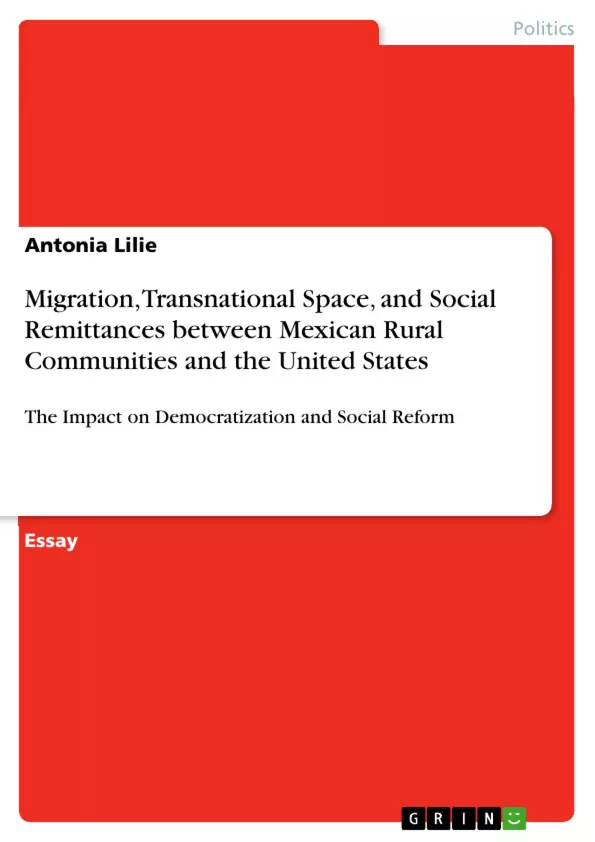In 2006, more than 30% of all immigrants residing in the United States were Mexicans, accounting for one tenth of the entire Mexican population (Migrationinformation). This makes Mexico the most important and most consistent sending country for immigrants to the U.S. The co-existence of two very different worlds in the geographical space North America, divided by one of the most secure borders in the world, leads not only to cultural influences, but also to the adaptation of socioeconomic and political ideas. Especially the fact that Mexico and the United States have very different political and socioeconomic conditions emphasizes the oppositional relationship between the two countries. In the face of such a strong and powerful neighbour, migration is always an option, a last resort, especially for Mexicans from rural communities that struggle with poor working conditions and low wages. Interestingly, this creates a certain type of migration known as transmigration. This transmigration occurs only due to socioeconomic reasons, especially labour conditions, and allows migrants to frequently travel back and forth between their home- and their host country. Since many of these transmigrants are young men who leave their families behind to earn money that they can then send back home in the form of financial remittances, different patterns of communication between these migrants and their relatives back home can be analyzed.
This paper will first outline the situation of Mexican migrants to the United States, give a brief overview of their backgrounds and the demographic situation, and then turn to the push—factors for migration. It will especially focus on labour rights and working conditions in Mexico and the prospects for migrants arriving in the United States. After that
the concept of ‘Social Remittances‘ as a form of cultural diffusion will be introduced and
the quality of ideas and experiences that are transmitted through a transnational space from Mexicans residing in the U.S. to their families and community members back home will be explained. The paper will then turn to an analysis of these social remittances and explain how they can influence political participation and activism of individual community members. This analysis serves to support the thesis that migration has a direct influence on the process of democratization from below, especially when it comes to labour rights and other socioeconomic issues.
Inhaltsverzeichnis (Table of Contents)
- Introduction
- Demographics of migration
- Labour rights as push—factors for migration
Zielsetzung und Themenschwerpunkte (Objectives and Key Themes)
This paper explores the impact of migration from Mexico to the United States on democratization and social reform in Mexican rural communities. It analyzes the factors driving migration, including the socioeconomic circumstances and labor rights challenges faced by Mexicans. The paper then introduces the concept of "social remittances" and investigates how these cultural exchanges influence political participation and activism within these communities.
- Mexican migration to the United States
- Push factors for migration, specifically labor rights and working conditions
- Social remittances as a form of cultural diffusion
- Impact of migration on political participation and activism
- The role of migration in democratization from below
Zusammenfassung der Kapitel (Chapter Summaries)
- Introduction: The paper establishes the context of Mexican migration to the United States, highlighting the demographic trends and the contrasting socioeconomic and political conditions between the two countries. It introduces the concept of transmigration and the role of financial remittances in shaping communication patterns between migrants and their families back home.
- Demographics of migration: This chapter analyzes the demographic characteristics of Mexican immigrants in the United States, focusing on the prevalence of single or married working males employed in specific sectors. It discusses the evolution of migration patterns over time, including the increasing participation of women and children.
- Labour rights as push—factors for migration: This section examines the socioeconomic and labor rights factors that contribute to Mexican migration. It highlights the history of labor rights struggles in Mexico and the impact of neoliberal reforms on working conditions, particularly in rural communities. The chapter also explores the role of employers in perpetuating low labor costs and the decline of organized labor.
Schlüsselwörter (Keywords)
This study explores themes of migration, transnational space, social remittances, democratization, social reform, labor rights, working conditions, and political participation, drawing on the experiences of Mexican migrants in the United States and their impact on rural communities in Mexico.
- Arbeit zitieren
- Antonia Lilie (Autor:in), 2012, Migration, Transnational Space, and Social Remittances between Mexican Rural Communities and the United States, München, GRIN Verlag, https://www.grin.com/document/193915



